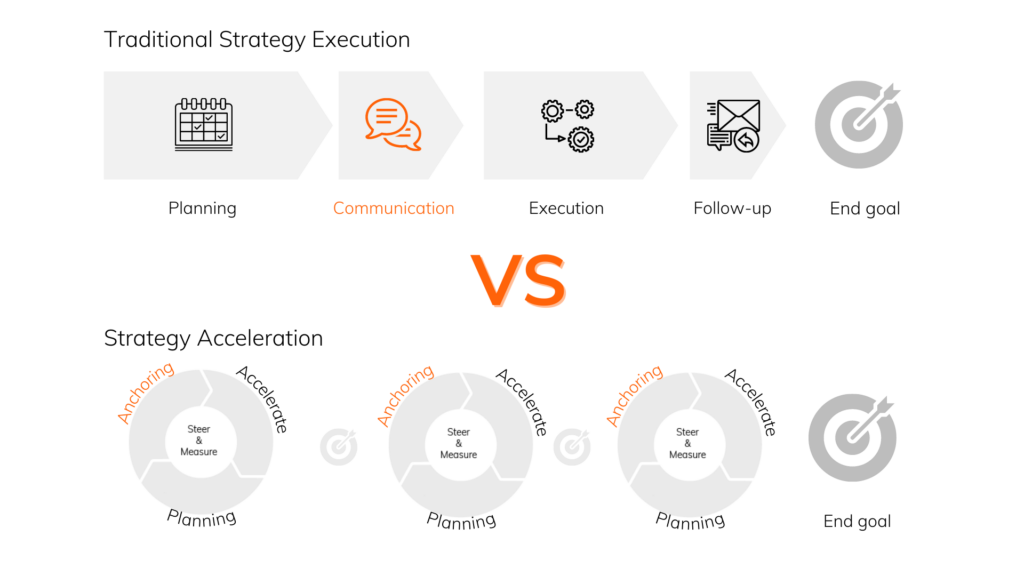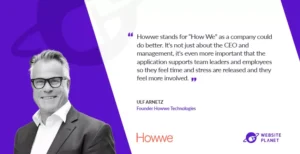In our blog series based on the book “Strategy Acceleration” by Ulf Arnetz and Catrin Brodin, we aim to provide insights and guidance on executing and realizing company strategies. Many companies struggle with strategy execution, and in order to avoid falling into the same trap, it is essential to understand the differences between traditional strategy execution and strategy acceleration. In this post, we will focus on the fundamental aspect of time.
To succeed, it is necessary to challenge ingrained opinions and act differently. A good starting point is embracing open-mindedness and daring to think in new ways. We refer to this innovative approach as “the new way” of carrying out strategies, which we call Strategy Acceleration.
We will compare traditional strategy execution with strategy acceleration, highlighting the contributing factors behind the challenges faced by many companies in executing their strategies. By exploring the contrasts between the two approaches, we aim to shed light on what needs to be done differently. Strategy acceleration empowers organizations to implement changes within a shorter time frame and according to set targets, distinguishing it from traditional strategy implementation
.

In one example, we will describe the typical approach in traditional strategy execution, which may resonate with readers. This will make the contrasts even more apparent, allowing a clearer understanding of the significant differences between the two approaches. In the other example, we will delve into strategy acceleration.
These comparisons emphasize the need to think differently and step outside the confines of traditional methods. While reading this blog post, we encourage you to reflect on the current state of affairs in your organization.
It’s About Time: Traditional Strategy Execution is Too Slow
First and foremost, we want to redefine the terms used. While most companies talk about strategy implementation or strategy execution, we advocate for strategy acceleration. The distinction lies not in the definition but in the actual execution. Acceleration implies the need for greater speed and highlights the importance of time. The difference between the two methods lies in the fact that strategy acceleration involves multiple activities within a short time frame, whereas traditional execution centers around a single large activity over an extended period.
Although we may generalize to some extent, our collective experience suggests that in most companies, strategy execution follows a similar pattern:
Planning:
- The CEO and management realize the need for action but take an excessively long time to transition from discussions to action.
- A plan is eventually created, often with the involvement of management or external consultants.
- However, excessive reliance on external companies can result in a loss of ownership over strategic issues.
- The resulting strategy document, which took too long to create, may already be outdated or irrelevant by the time it is finalized.
Communication:
- This phase involves various communication activities aimed at spreading the message and ensuring employees understand the strategy and its goals.
- A communication plan is devised, and the CEO typically addresses the strategy in a large meeting.
- Managers or the Communication department take on the responsibility of further communicating the strategy within their respective departments.
Implementation:
- After the strategy has been communicated, it is time for execution.
- However, there is often no clear plan for how the execution will be handled, leaving this task to individual managers.
- Numerous strategic areas are identified, resulting in a multitude of goals to be defined and pursued.
- This can lead to a sense of scattered efforts and too much happening simultaneously.
Follow-up:
- There is a time plan for creating, communicating, and executing the strategy, aiming to ensure the achievement of goals and lasting effects.
- However, this phase is often inadequate, with many companies admitting to being ineffective at following up on set targets.
- Follow-up activities typically involve assessing rough milestones and the ultimate goal (e.g., increased revenue), but lack detailed monitoring.
- Without ongoing follow-up, it becomes impossible to determine if the right activities are being pursued to move closer to the goal.
Does this method of strategy execution sound familiar? If so, you are not alone. Let’s now compare it to the strategy acceleration approach.
We frequently observe this process, and the outcome is consistently unsatisfactory. This method fails to help organizations achieve their goals and is hindered by its sluggishness. It is not uncommon for this work to extend over 3-5 years.
Strategy Acceleration: Embracing a New Way of Thinking
So, how can we do things differently? The answer lies in adopting the strategy acceleration method—a simple, fast, and efficient approach. It is built upon several foundational elements that contribute to a successful strategy implementation.
Strategy acceleration emphasizes practical execution, moving the strategy from a mere document to a powerful component integrated into every employee’s daily work. It ensures that everyone understands how the strategy will be achieved and avoids leaving execution to drift aimlessly within the organization. From the outset, all employees are engaged and aware of their vital role in the journey toward the goal. Moreover, everyone works in unison, following a unified approach to progress together.
With Howwe, companies can align their strategy with their workforce, identify the prioritized areas crucial for achieving their most important goals, and execute the strategy accordingly.
In summary, strategy acceleration encompasses the following key areas:
- Identifying the most important goals — focuses on few but most value-adding goals
- End-goal is divided into intermediate goals which focus on the most important things
- There is a clear plan of how the strategy will be executed
- The activities that are being done are linked to the set targets
- Anchoring (organizational buy-in) is ongoing and an integrated part of the process
- Follow-up of results and work progress is made through continuous steering and measuring
By embracing strategy acceleration, organizations can overcome the limitations of traditional strategy execution and achieve their objectives efficiently. In our upcoming blog posts, we will further explore the concept of strategy acceleration and provide practical insights and strategies for successful implementation. Stay tuned!
What are you waiting for?
Howwe is the Solution for Growth.
With our method and software, we simplify the execution of your strategy.






